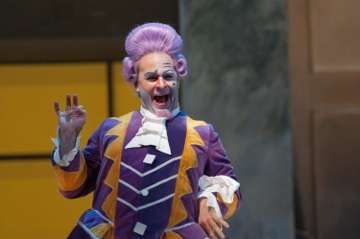|
Back
Seattle Opera presents frisky La Cenerentola Seattle
McCaw Hall
01/12/2013 - & January 13, 16, 19, 20, 23, 25, 26, 2013
Gioachino Rossini: La Cenerentola
Dana Pundt (Clorinda), Sarah Larsen (Tisbe), Daniela Pini (Cenerentola, Angelina), Arthur Woodley (Alidoro), Patrick Carfizzi (Don Magnifico), Rene Barbera (Prince Ramiro), Brett Polegato (Dandini)
Seattle Opera Orchestra & Chorus, Giacomo Sagripanti (Conductor)
Joan Font (Stage Director), Joan Guillén (Set and Costume Designer), Albert Faura (Lighting Designer), Xevi Dorca (Choreographer)

P. Carfizzi (© Elise Bakketun)
You can drop the fairy godmother and glass slipper from La Cenerentola, but you can’t take the fairytale out of Gioachino Rossini’s playful opera. He wrote it at age 25; bets are, he was in touch with his inner child.
If fairytales, with their clear definitions of good and evil, help explain the world to children, let’s not forget that adults need reminding that virtue can triumph in a zany, mixed-up world. And this high-spirited Barcelona-designed show illustrates this in colorful, convincing ways.
Angelina (Cenerentola) is sung by mezzo-soprano Daniela Pini, coincidentally born near Rossini’s parents’ hometown and making her American debut with this role. She does win Prince Ramiro (tenor Rene Barbera who reaches high C’s with ease) from true love and kindness. She doesn’t win by manipulation, luck or beauty. In a way, she is a self-possessed heroine, and how nice that opera can remind us that good people can triumph with room for generosity to forgive the meanies left in the dust. Still, the opera is not a morality tale; it remains a fairytale done up in the trappings of a child-pleasing story.
The wacky comic-book quality of the sets, costumes, make-up, and hair (how about purple hair-do for Don Magnifico and blue hair with dark glasses for the chorus?) let us know that this is opera buffo at its most imaginative. But the opera is miles from slapstick. Pieces fit together beautifully while each voice seamlessly expresses the character behind it. Don Magnifico’s (bass-baritone Patrick Carfizzi) patter exposes his nervous, dishonest character. Alidoro’s dark “La del ciel” shows the godfather-guide’s gravitas that bass Arthur Woodley embodies.
The colorful patchwork, including mismatched stockings, comes together as one well-made quilt that contains vivid, soaring ensembles. What better example than the sextet in the final act with “Questo e un nodo avviluppato” in which each character expresses surprise that the bracelet (not glass slipper) is, believe it or not, Angelina’s.
And here’s a final note on Rossini’s genius at matching music to his characters. If Angelina is the opera’s most compelling character, Pini’s Angelina plays down her mezzo; she is forever begging to be heard by her stepfather and stepsisters while they are deaf to her. When it’s clear she and the prince are a match, she lets it rip in the final aria, “Non più mesta.” It is the first time we truly hear the depth of her rich voice.
The rats (instead of mice) played by lithe and expressive dancers almost stole the show as they perform a kind of mute dancing chorus. Wigs off to choreographer Xevi Dorca, stage director Joan Font, and set/costume designer Joan Guillén for keeping us entertained on so many levels.
By the way, kids old enough to read the subtitles will enjoy the two-act show, though it lasts 2 1/2 hours. There is a 30-minute intermission.
Angela Allen
|